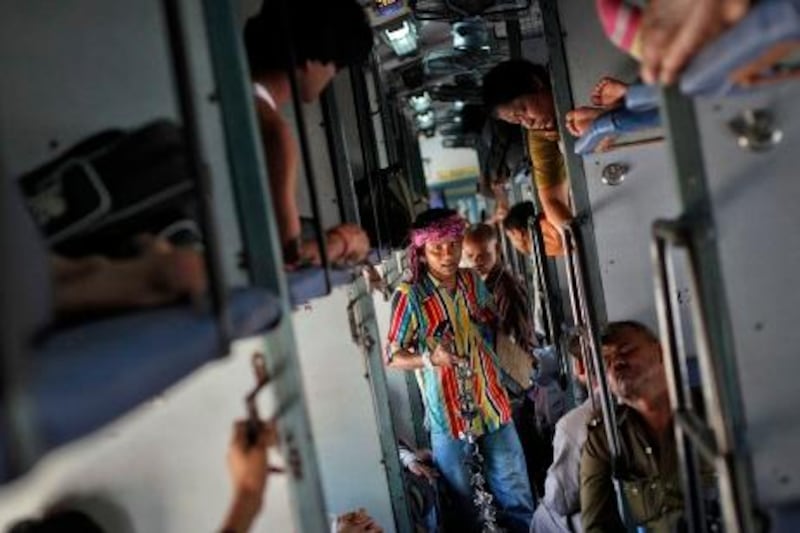NEW DELHI // Sridhar Joshi has had a lifelong love of Indian trains. A 20-year veteran of the Indian Railways Fan Club Association, he rides just for fun, memorising locomotive codes and hanging around railway sheds.
But even Mr Joshi, who works at Servion, a customer service firm in Chennai, admits the object of his affections is ailing.
"The decline has been perceptible, in terms of safety, train conditions and finance," he said.
Mr Joshi's recent trip from Chennai to Bangalore only made his criticisms sharper. Passengers without tickets filled a reserved coach and were not evicted, he said. The toilets were filthy, the food was awful, and railway staff threw rubbish out of the train's windows.
On a connecting train to the town of Hubli, he said, "the number of mice and cockroaches outnumbered the passengers" in his coach. "I eventually made it to my destination two hours late, missing my appointment."
The 160-year-old Indian Railways, with more than 114,000 kilometres of track running through 7,500 stations, is the fourth largest rail network in the world. Owned and operated by the central government, it has long been the backbone of India's transportation network, especially through the 20th century, when robust national and regional motorways were absent.
But as horror stories like that of Mr Joshi continue to multiply, analysts predict dire times ahead for the railway.
"Last year, I wrote a column saying that the Railways was in danger of slipping into a coma," said Akhileshwar Sahay, a transport and infrastructure analyst who is now an adviser to the Delhi Metro. "This year, I'd say the Railways has actually slipped into its coma."
In addition to running a dilapidated fleet with an alarming lack of facilities, as Mr Joshi says, the railway is mired in concerns over a lack of safety.
This year, there have been nine accidents. The most recent, which happened three weeks ago in Penukonda, Andar Pradesh, was also the most deadly, killing 25 people and injured more than 70. More than 50 people have died in train accidents so far this year.
"A large part of the Railways' capacity was built during the British era, and new capacity needs to be created" said S Ramnarayan, a professor at the Indian School of Business in Hyderabad. "The country is growing, in terms of economy and population. The Railways needs a big, bold vision, and it doesn't have one."
This year two government-appointed committees submitted reports on the safety and modernisation of the Indian Railways.
Both reports stressed the need for immediate heavy government investment into the Railways. The committee on rail safety, headed by Anil Kakodkar, the former chairman of the Atomic Energy Commission, called for an injection of 1 trillion rupees (Dh65.64 billion) over the next five years to significantly improve safety standards.
The committee on modernisation, even more ambitiously, reported that the agency would need another 9 trillion rupees over the next five years "as the current operations have gone sick". The money would overhaul tracks and trains, signalling and communications systems and also initiate high-speed rail services. But this money will be very difficult to find, especially from a government running a large fiscal deficit. This year, for instance, when the railway ministry asked for a one-time grant of 280 billion rupees - in addition to its regular budgetary support - it was turned down.
Mr Kakodkar, in his report, wrote that, financially, the Indian Railways "is at the brink of collapse unless some concrete measures are taken".
To be sure, as more Indians become mobile, and as the need for cargo services increases, the railroad's revenues are climbing steadily.
However in 2010-11, the Associated Chambers of Commerce and Industry of India (ASSOCHAM), a trade organisation, said in a report that the Indian Railways lost 140 billion rupees on its passenger traffic. "The core problem," the group said, "is that its losses mount with rising passenger traffic" - because ticket prices remain static even as expenses have mounted.
At one point during the 2011-12 fiscal year, a report by India's comptroller revealed that the Indian Railways' cash reserves had stood at just 7.5 million rupees before staging a recovery.
One solution for adding revenues involves raising passenger ticket fares. But political populism has often derailed this idea.
In his budget presented this year, Dinesh Trivedi, the railway minister and a member of the Trinamool Congress, a coalition party, attempted to raise ticket prices - by an amount that worked out to between 0.02-0.30 rupees per kilometre of travel.
It was the first price rise floated by a railway minister in nine years, but it generated intense political criticism, with several parties decrying the move as "anti-poor".
Even Mr Trivedi's party chief, Mamata Banerjee, demanded that he be removed from his post. He was duly shunted out, and his replacement announced a rollback of the proposed fare hikes.
"The Indian Railways is seen as a cow, and everyone is milking this cow," Mr Ramnarayan, the professor, said, when asked about raising ticket rates. "But who is going to feed the cow something? The cow needs sustenance too."
A marginal hike in fares will not solve the railroad's problems, he said, but it would have strong symbolic value.
"If a minister can't even raise the fares, then people will start to believe that nothing can be done for the Railways. They'll think: 'Why even try?' That is the larger meaning people derive from an action like this."
[ ssubramanian@thenational.ae ]





